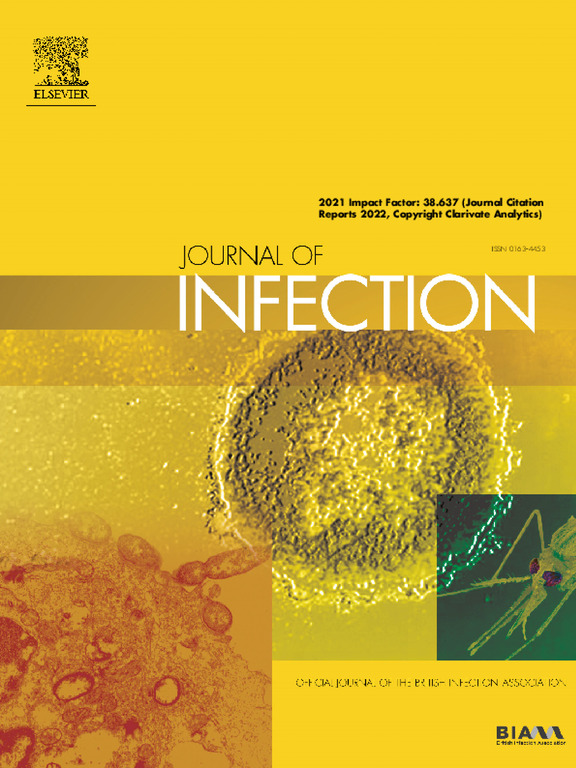Clinical and epidemiological investigation of human infection with zoonotic parasite Trypanosoma dionisii in China
IF 14.3
1区 医学
Q1 INFECTIOUS DISEASES
引用次数: 0
Abstract
Background
Trypanosomiasis continues to pose a global threat to human health, with human infection mainly caused by Trypanosoma brucei and Trypanosoma cruzi.
Methods
We present a 30-year-old pregnant woman with persistent high fever from Shandong Province, China. High-throughput sequencing revealed the presence of Trypanosoma dionisii in blood. We conducted an analysis of the patient’s clinical, epidemiological, and virological data.
Results
The patients exhibited fever, shortness of breath, chest tightness, accompanied by change in liver function and inflammatory response. She made a full recovery without any long-term effects. T. dionisii was detected in blood collected 23 days after onset of illness. The 18S rRNA gene sequence showed close similarity to T. dionisii found in bats from Japan, while the gGAPDH gene was closely related to T. dionisii from bats in Mengyin County, Shandong Province. Phylogenetic analysis demonstrated the current T. dionisii belongs to clade B within its species group. Positive anti-Trypanosoma IgG antibody was detected from the patient on Day 23, 66 and 122 after disease onset, as well as the cord blood and serum from the newborn. Retrospective screening of wild small mammals captured from Shandong Province revealed a prevalence rate of 0.54% (7/1304) for T. dionisii; specifically among 0.81% (5/620) of Apodemus agrarius, and 0.46% (2/438) of Mus musculus.
Conclusions
The confirmation of human infection with T. dionisii underscores its potential as a zoonotic pathogen, while the widespread presence of this parasite in rodent and bat species emphasizes the emerging threat it poses to human health.
中国人畜共患病寄生虫锥虫感染的临床和流行病学调查。
背景:锥虫病继续对全球人类健康构成威胁:锥虫病继续对全球人类健康构成威胁,人类感染主要由布氏锥虫和克鲁斯锥虫引起:方法:我们研究了一名来自中国山东省、患有持续高烧的 30 岁孕妇。高通量测序发现血液中存在狄奥尼斯锥虫。我们对患者的临床、流行病学和病毒学数据进行了分析:患者表现出发热、气短、胸闷,并伴有肝功能和炎症反应的改变。她完全康复,没有受到任何长期影响。在发病 23 天后采集的血液中检测到了狄奥尼氏菌。18S rRNA基因序列显示与日本蝙蝠中的T. dionisii近似,而gGAPDH基因与山东省蒙阴县蝙蝠中的T. dionisii关系密切。系统进化分析表明,目前的T. dionisii属于其种群中的B支系。在患者发病后第23天、第66天和第122天,以及新生儿的脐带血和血清中均检测到阳性的抗锥虫IgG抗体。对山东省捕获的野生小型哺乳动物进行的回顾性筛查显示,T. dionisii的感染率为0.54%(7/1304),特别是在Apodemus agrarius和Mus musculus中的感染率分别为0.81%(5/620)和0.46%(2/438):人类感染 T. dionisii 的确认突显了其作为人畜共患病病原体的潜力,而这种寄生虫在啮齿动物和蝙蝠物种中的广泛存在则强调了它对人类健康构成的新威胁。
本文章由计算机程序翻译,如有差异,请以英文原文为准。
求助全文
约1分钟内获得全文
求助全文
来源期刊

Journal of Infection
医学-传染病学
CiteScore
45.90
自引率
3.20%
发文量
475
审稿时长
16 days
期刊介绍:
The Journal of Infection publishes original papers on all aspects of infection - clinical, microbiological and epidemiological. The Journal seeks to bring together knowledge from all specialties involved in infection research and clinical practice, and present the best work in the ever-changing field of infection.
Each issue brings you Editorials that describe current or controversial topics of interest, high quality Reviews to keep you in touch with the latest developments in specific fields of interest, an Epidemiology section reporting studies in the hospital and the general community, and a lively correspondence section.
 求助内容:
求助内容: 应助结果提醒方式:
应助结果提醒方式:


